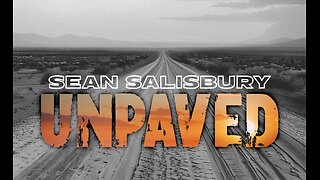Premium Only Content

Episode 3281: The Frankenchurch: The Tragic Experiment of the Modern Church
November 3, 2025
www.catholic-reboot.com
Nightly Zoom Coordinates for Rosary:
Meeting ID: 865 8978 0399
Passcode: Wjjv4960!
Speak Lord for your Servant is Listening
Book Recommendation of the Day
St. Robert Bellarmine – De Controversiis and De Ecclesia Militante
Theme: The nature of the Church, her marks, and how to recognize the true Church amid heretical confusion.
“The Church is one, holy, catholic, and apostolic. To separate from her unity under pretext of reform is to abandon Christ Himself.”
Why this fits:
Bellarmine’s treatises defend the visible, hierarchical, and divinely instituted nature of the Church against Protestant innovations. His writings expose how attempts to “update” or “reform” the Church apart from Tradition always lead to schism and heresy just as the post-conciliar reforms did.
The Frankenchurch: The Tragic Experiment of the Modern Church
Episode rooted in faith, truth, and the timeless teachings of Holy Mother Church.
We live in days of confusion, where even what was once unthinkable is now spoken from pulpits and chanceries. Word is spreading that Rome may soon declare the chastisement apparitions of Fatima, Akita, and La Salette “null and void” dismissing Heaven’s own warnings as superstition or private hysteria. Should this occur, it will mark a turning point unlike any before it a spiritual civil war within the Church.
Now why would the modern church take such a position? Well for anyone that remembers, the Pope who opened the Catholic Church to a kind of Frankenstein experiment Pope John XXIII himself said in the opening speech to Vatican II on October 11, 1962 that those Catholics believing and guarding the warnings of Fatima especially around the the 3rd secret he refused to pronounce were
“Prophets of Doom”
In his famous Gaudet Mater Ecclesia address at the opening of the Second Vatican Council, Pope John XXIII directly criticized those within the Church who spoke of divine chastisement, apostasy, or impending disaster:
“We feel we must disagree with those prophets of doom, who are always forecasting disaster, as though the end of the world were at hand.”
He was referring, indirectly, to traditional clergy and laypeople who warned that the Church’s accommodation to modernity would lead to apostasy and also to devotees of Marian apparitions such as Fatima and La Salette, which included clear warnings of chastisement if mankind did not repent.
Thus, John XXIII’s optimistic vision for the Council deliberately contrasted with the tone of past papal condemnations (e.g., Pius IX’s Syllabus of Errors or Pius X’s Pascendi Dominici Gregis). He wished to emphasize “the medicine of mercy” instead of “severity.”
3. Private revelations under John XXIII
John XXIII treated most modern apparitions with reserve, especially those predicting punishment or apostasy.
• He never publicly endorsed Fatima or La Salette
• He avoided granting official status to newer apparitions that emphasized chastisement.
His approach reflected his belief that the Church should focus on dialogue and hope, not warnings and reproofs.
The Church, long divided in practice and spirit since Vatican II, now teeters on the edge of an open split.
On one side, the faithful remnant clinging to Tradition and the perennial Magisterium; on the other, those who have exchanged revelation for relevance, truth for tolerance, and the Cross for comfort.
Today’s episode bears an unusual title a name coined by Fr. Caketa The Frankenchurch.
But behind the satire lies a sobering reality. Like Dr. Frankenstein’s grotesque creation, the modern Church has been cobbled together from incompatible parts liberal theology, ecumenical compromise, and secular humanism all stitched into what was once the spotless Bride of Christ.
This so-called “renewed Church” is not the living continuation of the Mystical Body but an engineered imitation, a hybrid faith fabricated by men who believed they could improve upon Divine Revelation.
It moves, speaks, and occupies the same sacred buildings but the soul that once animated it, the fire of supernatural grace and fidelity to Tradition, flickers faintly beneath layers of novelty.
In my book titled “Vatican II and the Forgotten Councils” goes into great detail on this matter,
Segment 1: The Birth of the Frankenchurch
Our story begins in the dimly lit laboratory of reform, called Vatican II, representing the modernist spirit of the 20th century, gathers the tools of his trade: reason without faith, compassion without truth, and reform without reverence.
John 23rd sees the Church not as the Mystical Body of Christ, but as an outdated institution in need of “updating” what the world called aggiornamento.
Like Frankenstein sewing together corpses, he stitches fragments of heresy and half-truth:
• From Protestantism, he borrows the emphasis on the community meal while neglecting the Sacrifice.
• From the Enlightenment, he takes human reason as the supreme authority.
• From modern psychology, he imports a self-help gospel that treats sin as sickness rather than rebellion against God.
He fashions a new creation a Church for the modern age.
But when the lightning of human pride strikes, the creature rises not in sanctity, but in spiritual deformity.
What emerges is a Church stripped of its transcendence. The sacred tongue of Latin is silenced, replaced by banal and casual speech. Altars of sacrifice become tables of fellowship. The priest, once mediator between God and man, now stands as entertainer and social worker.
The supernatural has been traded for the sociological; mystery for management; sacrifice for sentiment.
And the faithful, bewildered, stand before this creature this “renewed Church” which moves, gestures, and preaches, but no longer inspires awe.
Segment 2: The Madness of the Laboratory
In the laboratory of reform, John 23rds mantra was “open to the world.” But the world he opened the Church to was already closing its heart to God.
His sacred tools aggiornamento and dialogue soon became weapons of demolition. “Updating” meant discarding what was holy. “Dialogue” meant never proclaiming truth with certainty. And thus the altar turned outward. The priest faced the people, as if man were now the focus of worship rather than God.
The Council chambers buzzed with new vocabulary words that sounded profound but carried no anchor: subsists in, pastoral, people of God, signs of the times. These phrases, intentionally vague, allowed every bishop and theologian to interpret them as he wished.
The result? Ambiguity became doctrine. Relativism became charity.
Soon the laboratories of reform produced endless experiments:
• Liturgical committees dissected centuries of worship.
• Lay ministers replaced the sacred duties of consecrated hands.
• Synods and commissions multiplied like mirrors in a hall of confusion.
And now, decades later, the latest experiment the so-called “Synodal Church” threatens to dissolve what remains of structure, authority, and faith itself. The monster has grown. It has learned to speak the language of inclusion, to smile while it devours, and to proclaim mercy while denying truth.
Like the creature in Shelley’s tale, it has escaped its maker’s control. The reformers, long gone, are buried under the ruins of their own experiment.
Segment 3: The Monster Turns on Its Maker
The generation that once marched under banners of “renewal,” “peace,” and “modernization” now watches its parishes close, its seminaries empty, and its children drift into unbelief.
The Frankenchurch, like all monsters, has turned against its maker.
It mocks the very architects who built it.
It preaches about the climate while ignoring the soul.
It kneels before the idols of Pachamama while ignoring the tabernacle.
It honors every religion but the true one and blesses every lifestyle but the holy one.
This Church of man has enthroned human respect where once the fear of God reigned. It replaces repentance with self-affirmation and sanctity with “dialogue.” It embraces the world’s sins under the pretext of compassion, yet despises the purity of the saints.
Now the monster, restless and grotesque, seeks more pieces to attach LGBT ideology, feminist priesthoods, liberation theology, and Marxist sociology.
Each new graft disfigures the Bride further, until she is scarcely recognizable beneath the scars of compromise. This is the Bride of Frankenchurch.
And yet, like Frankenstein’s creation, this modern Church will never find rest, for it is separated from the life-giving blood of Tradition and the Sacred Heart of her Divine Spouse.
Segment 4: The True Church Cannot Die
Amid the ruins, however, the true Church lives.
She is the Bride of Christ immortal, immaculate, and indestructible. The gates of hell shall not prevail against her.
Her heart still beats in the rhythm of the Traditional Latin Mass, where silence, reverence, and sacrifice draw souls to Calvary. Her children gather in humble chapels, catacombs of fidelity scattered across the world. There, the ancient chant rises like incense, defying the chaos of modernism.
This remnant the “little flock” has not abandoned the Cross for convenience. They cling to the truths handed down by the saints, popes, and martyrs. They recognize that Christ’s Church does not evolve with the culture; it transforms the culture through grace.
Even as the Frankenchurch boasts of inclusion, the faithful remnant clings to exclusion from error. Even as the new hierarchy praises man, the remnant kneels before God.
In this faithfulness lies hope. The blood of the martyrs still cries out beneath the altar, reminding us that the Church of the ages cannot die she only hides herself for a time in the wilderness, waiting for resurrection.
Segment 5: A Call to Reclaim the True Faith
We are not called to despair, dear friends, but to fight with faith. Our battle is not with flesh and blood but with the principalities and powers that seek to deform the Bride of Christ. The antidote to John 23rd Frankenchurch is not anger but fidelity.
Each Rosary prayed is a hammer blow against the laboratory walls of modernism.
Each reverent Mass attended, each confession made, each act of penance offered—these are the stitches of restoration repairing the torn garment of the Church.
As St. Pius X warned in Pascendi Dominici Gregis, modernism is “the synthesis of all heresies.” It masquerades as renewal while spreading decay. It promises freedom while enslaving the faithful to doubt.
Our mission, then, is to live in holiness, pray without ceasing, and anchor ourselves in the timeless truth that Christ, not culture, defines the Church.
We must be the faithful sons and daughters who rebuild from within brick by brick, prayer by prayer, Mass by Mass until the Bride is clothed once more in the splendor of Tradition.
Conclusion
Let us pray for those still caught in the illusion of the Frankenchurch that they may rediscover the beauty of the true Faith, uncorrupted and radiant with grace.
Let us pray for our priests and bishops, that they may awaken from the intoxication of novelty and return to the altar of sacrifice, not the stage of self-expression.
Though the Frankenchurch stumbles in its confusion, the true Church stands radiant in the light of eternity.
Christ did not build His Church in a laboratory; He built it on the Rock of Peter, consecrated by blood, preserved by Tradition, and destined for triumph.
We echo the words of St. Athanasius, who lived through a time when nearly the entire hierarchy fell into heresy:
“They have the buildings, but we have the Faith.”
Hold fast, dear listener. The storm may rage, but the Ark of Tradition will not sink.
For Christ, the Divine Builder, will one day return not to the laboratory but to His spotless Bride, purified through fire, adorned once more for her heavenly Bridegroom.
Epistle – 1 Corinthians 15:51–57
“Behold, I tell you a mystery: We shall all indeed rise again; but we shall not all be changed. In a moment, in the twinkling of an eye, at the last trumpet, the dead shall rise incorruptible, and we shall be changed. For this corruptible must put on incorruption, and this mortal must put on immortality… But thanks be to God, who hath given us the victory through our Lord Jesus Christ.”
Reflection on the Epistle
Here, St. Paul reveals one of the most awe-inspiring truths of the faith the resurrection of the body. This is not a poetic idea or a spiritual allegory, but a dogma: every soul will be reunited with its body on the Last Day.
This mystery of transformation from corruption to incorruption points us to the perfection of God’s plan. Death entered through sin; life eternal comes through Christ. The Apostle reminds us that our battle is not in vain, for Christ’s Resurrection has already conquered death’s sting.
St. John Chrysostom once thundered:
“O death, where is thy sting? O grave, where is thy victory? Christ is risen, and thou art overthrown!”
Traditional Catholics live in the light of this triumph aware that suffering, penance, and fidelity on earth are not meaningless, but seeds of eternal glory. Every Holy Mass, every act of charity, every prayer for the dead participates in this cosmic victory.
Thus, we should live with a warrior’s confidence and a saint’s humility, for we fight under the banner of the Risen King.
Gospel – John 5:25–29
“Amen, amen, I say unto you, that the hour cometh, and now is, when the dead shall hear the voice of the Son of God, and they that hear shall live. For as the Father hath life in Himself, so He hath given to the Son also to have life in Himself; and He hath given Him power to do judgment, because He is the Son of Man.”
Reflection on the Gospel
In today’s Gospel, Our Lord declares that He alone holds the authority of life and judgment. His words cut through all illusions of human autonomy. The Son of God is the final arbiter every soul will stand before Him.
Here, Christ reveals the double resurrection: first spiritual, then physical. The spiritual resurrection occurs in baptism and grace when a soul dead in sin is raised to life in Him. The physical resurrection will occur at the end of time, when He calls all the dead from their tombs.
For those who live in sanctifying grace, that call will be a summons to glory. But for those who rejected His mercy, it will be the sound of condemnation.
This is why Holy Mother Church continually exhorts her children to live as those who must one day give account. Confession, frequent reception of the Eucharist, prayer for the dead, and devotion to the Sacred Heart are not pious extras they are preparation for that hour when we, too, will hear the voice of the Son of God calling us forth.
Feast Day Reflection – The Faithful Departed and the Hope of Victory
Although today is not liturgically the Feast of All Souls, the octave continues, reminding us that the faithful departed still await their full share in Christ’s victory.
St. John Vianney once said:
“If we truly understood Purgatory, we would do everything possible to avoid it and to deliver souls from it.”
The traditional Catholic understands that our communion with the faithful departed is not sentimental it is supernatural. The Holy Sacrifice of the Mass, indulgences, and the Rosary all assist those souls being purified for Heaven.
In this way, we fulfill St. Paul’s call: “Bear one another’s burdens, and so you will fulfill the law of Christ.” We not only assist the living but also the dead, uniting the Church Militant and the Church Suffering under the reign of Christ the King.
Practical Application – Living for the Final Resurrection
1. Offer Daily Prayers for the Dead.
Especially during November, unite your Rosary or Divine Office with intentions for the Holy Souls.
2. Live in the State of Grace.
Frequent confession ensures that the “voice of the Son of God” will be one of welcome, not warning.
3. Adore the Eucharistic Christ.
The same Lord who will raise us from the tomb comes daily to us under the veil of bread and wine.
4. Work While It Is Day.
Use every moment of suffering, labor, or joy for His glory. St. Paul reminds us that “our labor in the Lord is not in vain.”
Conclusionary Prayer
O Lord Jesus Christ, who hast conquered death and bestowed upon us the hope of the resurrection, grant us the grace to live each day as pilgrims toward eternity.
May we, strengthened by Thy sacraments, purified by Thy grace, and consoled by the prayers of the Blessed Virgin Mary, persevere unto the end.
Receive, O Lord, the souls of the faithful departed, and grant them rest in Thy light. And when our hour comes, may we rise in Thee to everlasting joy.
Through Christ our Lord. Amen.
St. John Chrysostom, pray for us.
Sacred Heart of Jesus, have mercy on us.
Immaculate Heart of Mary, intercede for us.
-
 2:17:37
2:17:37
The Quartering
3 hours agoFooled Again! Mamdani Backtracks Everything & Today's Breaking News!
158K64 -
 1:17:04
1:17:04
DeVory Darkins
4 hours agoPelosi SURRENDERS announces retirement and Bernie Sanders makes stunning admission
80K94 -
 LIVE
LIVE
StoneMountain64
4 hours agoArc Raiders is actually INCREDIBLE
262 watching -
 LIVE
LIVE
FusedAegisTV
5 hours agoFUSEDAEGIS PLAYS THE GREATEST JRPG EVER MADE ⌛► CHRONO TRIGGER (1995) Part 4
46 watching -
 1:57:50
1:57:50
The Charlie Kirk Show
5 hours agoErika's Interview + Auburn Aftermath | Schlichter, Lomez | 11.6.2025
86.8K17 -
 LIVE
LIVE
ZWOGs
4 hours ago🔴LIVE IN 1440p! - ARC RAIDERS w/ @SilverFox & @svgames! - Come Hang Out!
35 watching -
 LIVE
LIVE
The Rabble Wrangler
14 hours agoBattlefield with The Best in the West
75 watching -
 1:02:01
1:02:01
Sean Unpaved
4 hours agoTragedy Strikes: Kneeland's Remembrance, Spo's Inferno, CFB HC Rumors, & TNF Raiders-Broncos' Odds
56.5K -
 LIVE
LIVE
BigTallRedneck
7 hours ago3K 3XL TAKEDOWN - PGA 2K25/REDSEC/ARC RAIDERS
29 watching -
 LIVE
LIVE
GritsGG
5 hours agoSolos! #1 Most Warzone Wins 3920+!
13 watching